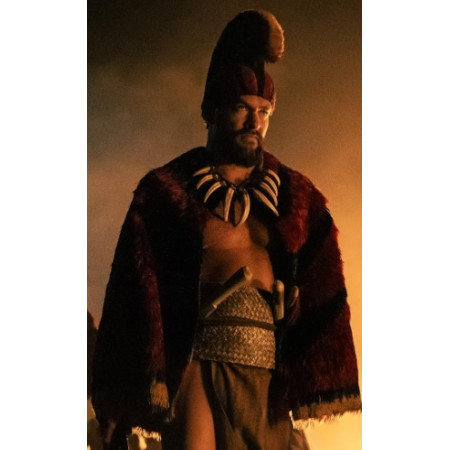Chief of War Costume A Bold Statement of Power and Tradition

Jason Momoa’s Chief of War Costume: Why It Stays on Your Mind

Table
of Contents
- First Impressions
- The Show and Its Setting
- Hawaiian Roots Behind the Look
- What the Colors and Fabrics Say
- Why Fans Won’t Stop Talking About It
- Replicas and What You’re Actually Buying
- Styling Ideas for Everyday Use
- How to Take Care of It
- The Bigger Picture: Respect and Culture
- Final Thoughts
- FAQs
1.
First Impressions
Let’s be honest — when Jason Momoa
walked on screen in Chief of War, you didn’t just see a costume. You saw
presence. The red cloak, the raw textures, the way it moved with him. It
wasn’t flashy like a superhero outfit. But it didn’t need to be. It had weight.
You immediately buy into him as a
leader. That’s not just acting — that’s the clothes working with him.
2.
The Show and Its Setting
For anyone who hasn’t caught it yet,
Chief of War is set in late 1700s Hawaii, back when the islands were
being unified under King Kamehameha I. It’s a period packed with tension,
battles, and politics.
Momoa didn’t want the show to fall
into the “generic tribal warrior” trap. He pushed for real cultural accuracy.
Costume designer Kirsty Leishman teamed up with historians and Hawaiian
consultants, so the outfits echo actual garments like kapa cloth (made from
bark fibers) and feather cloaks worn by chiefs.
That’s why the moment feels so
different compared to Hollywood stereotypes. It’s rooted in truth.
3.
Hawaiian Roots Behind the Look
Here’s where it gets interesting.
The red tones aren’t just for drama. In Hawaiian culture, red was
sacred. Chiefs wore it as a mark of power. The cloak-like drape? A direct nod
to the ahuʻula feather cloaks, which weren’t just pretty—they symbolized
divine protection and leadership.
Even the rough texture of the fabric
mimics kapa cloth. Nothing here feels random. It’s all deliberate, and that’s
why it comes across with so much force on screen.
4.
What the Colors and Fabrics Say
Think about it: red paired with
earthy shades. On one hand, it screams power; on the other, it grounds him in
the land and people. It’s not armor, but the layers give the same sense of
protection. The patterns? Subtle, but enough to remind you that this isn’t
“costume jewelry.” Its identity.
Now, of course, the show didn’t use
actual kapa or feathers (too fragile and too sacred). Instead, they recreated
the feel with sturdier modern fabrics. Replicas follow the same path: woven
exteriors, comfortable linings, and deep crimson shades that hold up whether
you’re wearing it at Comic Con or using it in a photoshoot.
5.
Why Fans Won’t Stop Talking About It
The promo photos dropped, and suddenly
the internet exploded. Cosplayers wanted tutorials. Collectors started hunting
for replicas. Even style magazines pointed out how the color palette and
silhouette could bleed into modern fashion trends.
It’s rare for a period piece costume
to make it into the mainstream, but Jason Momoa has that effect. Just like his Aquaman
tattoos and jewelry started trends, this costume hit a nerve. It feels ancient
and modern all at once.
6.
Replicas and What You’re Actually Buying
Here’s the deal: you’re not going to
get authentic kapa or feathers in a store. Those are cultural treasures, not
for sale. What you can get are replicas that take the vibe and make it
wearable.
Places like America's Suits sell versions
built for fans. Usually, you’re looking at:
- Heavy woven fabric on the outside
- Soft lining (cotton or viscose)
- Rich maroon cloak, sometimes layered with earth tones
- Reinforced stitching so it doesn’t rip after one use
So no, it’s not “museum authentic.”
But for cosplay, collectors, or even fashion shoots? It works.
7.
Styling Ideas for Everyday Use
You don’t have to go full “Chief of
War” every time you wear it. A few ideas:
- Streetwear inspo:
Throw the cloak over dark jeans and boots. Keep the rest minimal.
- Cosplay mode:
Go all in with jewelry, boots, and maybe even a staff. Great for
conventions.
- Photography/editorial: It shines in moody lighting or natural outdoor shoots.
It’s versatile, which is why fans
are adapting it outside the series.
8.
How to Take Care of It
Treat it like more than just another
hoodie. If you snag a replica, here’s how to keep it looking sharp:
- Hand wash or use cold water on a gentle setting.
- Avoid harsh detergents.
- Always air dry (direct sunlight will fade the red).
- Store folded instead of hung, so it holds its shape.
Handled right, it’ll last years.
9.
The Bigger Picture: Respect and Culture
One thing worth pointing out:
Hawaiian warrior attire isn’t just a “cool look.” It carries meaning. Wearing a
replica isn’t a problem if you acknowledge that heritage.
A lot of cosplayers add captions or
posts explaining the history when they wear it. That’s the right way to go
about it — appreciation, not appropriation. And it actually makes the whole
experience more powerful.
10.
Final Thoughts
Jason Momoa’s Chief of War costume is unforgettable because it does more than make him look good. It’s
tied to history, to culture, and to identity. When he steps into frame, the
outfit speaks before he even opens his mouth.
That’s why fans are still buzzing
about it. Whether you buy a replica, adapt it into your style, or just admire
it from the show, it’s one of those costumes that stays with you.
It’s not just clothing. It’s a story,
stitched into fabric.
11.
FAQs
Q1. What inspired the Chief of War
costume?
Real Hawaiian garments like kapa bark cloth and feather cloaks, adapted for TV.
Q2. Can I buy the same one Momoa
wore?
Nope. The authentic versions are sacred and museum-kept. Replicas are the
closest you’ll get.
Q3. How do I wear it casually?
Layer it over jeans and boots. Let the cloak be the star; keep everything else
simple.
Q4. Is it disrespectful to wear?
Not if you treat it respectfully. Share the story behind it, don’t mock it.
Q5. How do I clean it?
Hand wash or dry clean. Always air dry and avoid strong sunlight.
